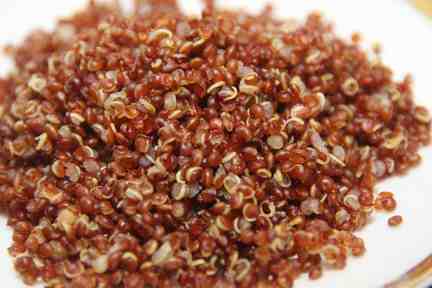Grown high in the Andean region of South America for 7,000 years, quinoa is a plant cultivated mainly for its nutrient-dense seeds. According to a report by PROINPA, a nonprofit Bolivian agricultural organization, the seeds contain anywhere from 13.8 to 21.9 percent protein, which is comparable with milk. Quinoa is also gluten-free and contains all of the vitamins, minerals, and essential amino acids. The UN Food and Agriculture Organization (FAO) identifies quinoa as the only gluten-free plant food that contains all of these nutrients.
There are more than 3,000 varieties of quinoa, and they grow in a variety of climates and altitudes, ranging from the sea-level Bío Bío Region of Chili to the 4,000-meter-high Andean Plateau in Bolivia and Peru. Although there are many types of quinoa, the most common varieties have tiny seeds that are slightly nutty in flavor and similar in texture to couscous; they come in red, black, and white. Quinoa’s genetic diversity and ability to adapt—along with its remarkable nutrition—makes it a powerhouse crop.
Recognizing that these tiny seeds have the potential to create great change in global health, the United Nations declared 2013 the International Year of Quinoa (IYQ) in efforts to raise awareness of this superfood.
Quinoa is a nutritious food that is neither labor-intensive nor expensive to grow. According to FAO, these qualities make quinoa ideal for countries suffering from malnutrition. The PROPINA report also notes that the crop has not only flourished and produced high grain yields in its native South America, but also in North America, northern Europe, northern India, and Kenya as well.
A recent report on National Public Radio also shows how quinoa cultivation is growing in the US. In Oregon, nursery owner Frank Morton has been breeding and growing quinoa seeds for nearly 30 years. He says that figuring out where certain varieties can grow is a challenge since heat and rain can easily damage the crop, but that quinoa still thrives in Oregon. He believes that other regions of North America, including the Pacific Northwest, Rocky Mountains, and parts of Canada, are well-suited for quinoa production. Washington State University scientist Kevin Murphy, who also breeds and cultivates quinoa, concurs, saying, “We’re going to see quinoa being grown all over the place soon.”
The UN dedicated 2013 to quinoa because it believes that expanding cultivation of this crop into more countries can help contribute to global food security for the planet’s nearly 1 billion hungry people. Quinoa, although tiny, may be a key to fixing one of the world’s biggest problems.















